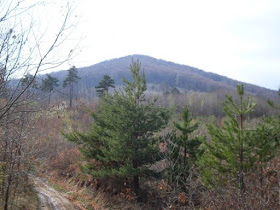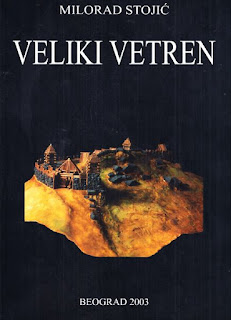In 1997, a group of hunters was chasing a fox up the slopes of the Veliki Vetren peak on Mount Juhor, Central Serbia.
Finally the fox reached the area which surrounds the peak and which is littered with giant bedrock outcrops.
There it disappeared in a hole under one of the rocks...
The hunters sent the hound in, and when it emerged back out with the dead fox in its mouth, the hunters noticed that the fox had "a piece of ceramic in its jaws" and that it was entangled "in some rusted irons"...
Tomica Stefanović from the local museum, who heard the story from the hunters, went to the fox hole to see it for himself. And after some poking around, he managed to get out of it a bronze spearhead...
He immediately informed dr Milorad Stojić from the Archaeological institute about his find. The fox hole dig led by dr Stojić unearthed over 400 metal objects:
Jewellery of Celtic type
Buttons with a Celtic triskelion
But the most amazing find was a complete equipment for 14 riders. A complete cavalry unit...A Celtic cavalry unit...From the 2nd c. BC...Why was this equipment buried on Veliki Vetren?
Now who were these Celts from Veliki Vetren? Most likely Scordisci, who at that time controlled northern Balkans...Apparently according to dr Milorad Stojić, the historical sources say that Scordisci cavalry units were lead by a leader and two lieutenants. The equipment found on Veliki Vetren confirms this, as three of the cavalry sets were more luxurious than the others.
The further digs in the area discovered that the whole top of the Veliki Vetren peak was fortified and turned into a Celtic oppidum.
Celts built the oppidum walls around the existing bedrock outcrops which they incorporated into the walls.

They also used large boulders to form the rest of the wall
Why would anyone want to build a fortress on Veliki Vetren? Those who controlled the Veliki Vetren peak, controlled the transport along the Morava valley below it, which was the main North-South transport route across the Balkans...
That controlling this part of Serbia was very important throughout Balkan history can be seen from the fact that remnants of 40 fortified settlements were found so far on the mountain Juhor...
So Celtic oppidum on Veliki Vetren was an important military centre, as can be seen from the military equipment found on the site, but it was also an important metallurgical centre, as can be seen from many smelting furnaces found on the site too...
Local villagers say that Veliki Vetren peak "attracts lightning"...Probably because huge amount of metal deposits, particularly slag, located in and around the Celtic oppidum...
Dr Stojić believes that the Celtic opidium was destroyed during the campaign against the Scordisci lead by the Cornelius Scipio Asiagenus in 74BC.
Dr Milorad Stojić published his findings in a book entitled "Veliki Vetren". He has since retired...
When the news about the discovery of the Veliki Vetren oppidum hit the archaeological circles, it caused a sensation..."Celtic lexicon" gave it a special place in its list of Celtic sites. Veliki Vetren is the only known Celtic fort and metallurgical centre south of the Sava and Danube rivers. Way out of the "Land of the Celts"...
One of the world's leading Celts researcher, professor Vaclav Kruta, considered Vetren one of the most important European Celtic sites.
But, promises made by the Serbian government that they will finance further digs on Veliki Vetren never materialised...No other investigation of the site was done by archaeologists and Veliki Vetren was soon forgotten...Well, by the archaeologists and the press. Not by treasure hunters who are the only people who dig around Mount Juhor today, based on numerous holes that can be seen everywhere in an around the Celtic oppidum...
Now this is amazing in itself. But it gets better...
There are many legends related to the "Devil's Town" on Veliki Vetren peak recorded in the villages surrounding the mountain. And the most famous story is the one about the "14 horsemen who came down the mountain on foggy nights and abducted young girls".
How incredible is this???
Now is it just a coincidence that the archaeologists have found exactly 14 sets of cavalry equipment in the "Devil's town"? I mean the number 14 is not one of the usual mythological numbers, like 1, 3, 7, 9, 10, 15, 30, 100 which are found in so many legends...14 is a very non mythological number...So the chance that this number was picked by the legend makers by chance is very very low... So what then? How old is this legend? Is it possible that it is dating to the time when "riders resided in the oppidum on Veliki Vetren" and from it, terrorised the local population in villages below? How then was it preserved to this day? Passed on from father to son in the villages surrounding Veliki Vetren since the 2nd century BC?
Now this is amazing in itself...But it gets better...
The legend also says that the riders from the Devil's Town "croaked like ravens" which obviously meant that they spoke in, to the local villagers, foreign and incomprehensible language, which to them sounded like croaking of ravens...
Now, believe or not, in the local Serbian dialect spoken in villages around Veliki Vetren, the word for raven is "gal"...So "the Galli (Celts) croaked like Gali (Ravens)"...
What? Is this a coincidence?
Does this have anything to do with "Galli"??? You know, the Celts?
I am not entirely sure...This could all be just a coincidence...
But:
Serbian word "gal" which means raven also means black...Black like a corvid...It is the word that gave us Kali and Cailleach...I talked about this in my post "Gal"...
This is indeed very interesting, I can hear you say. But what does any of this have to do with Celts? Particularly when we know that the Hellenistic folk etymology connected the name of the Galatians (Γαλάται, Galátai) to the supposedly "milk-white" skin (γάλα, gála "milk") of the Gauls.
Well I don't know...
It is this picture that makes me wonder:
"Four Provinces Bringing Tribute to Emperor Otto III" is an illustration from the manuscript: "Gospel Book of Otto III" which was made around the year 1000AD.
What is very interesting is that in this medieval depictions of the people of the Holy Roman Empire, each nation was depicted with different racial characteristics:
Sclavini, Slavs are depicted with dark skin and red straight hair.
Germanics were depicted with pale skin and blond straight hair.
Romans were depicted with pale skin and brown curly hair.
And
Galls were depicted with dark skin and black curly hair.
Was this deliberate? Was this based on what people thought Slavs, Germanics, Galls and Romans looked like at the time? Or was this random rubbish which means nothing?
If this was deliberate, is it possible that Gali once meant "people with black hair"???
I think it was deliberate, as Procopius in the 6th century AD says for Slavs: "Their skin is not very white and their hair is reddish".
Just like the depiction of Slavia in the Gospel Book of Otto lll...So I would say the rest is accurate too...
Also, Celts which lived on Veliki Vetren came to the Balkans in the 3rd century BC lead by Brennus. Apparently:
The recurrence of the name Brennus makes it possible that it was a title rather than a proper name. Some 19th century scholars connected the name with the modern Welsh word "breenhín", and Irish words "branán, braine, braineach" meaning "a prince, a chief, leader". There is also an Irish name "Bran" with the same meaning.
Now in Serbian the word "bran" means to defend, "brana" means defence, "Branko" means defender...So is it possible that Celtic Bran (prince, leader, chief) and Serbian Bran (defend), Brana (defence) and Branko (defender) come from the same root? Leader's first duty is defence of his people and his land...
Also, interestingly
In Breton word Bran means Raven and Crow.
In Welsh, word Frân mean crow and word Gigfran means raven. Fran is in old Welsh also spelt Bran, Vran and Uran.
In Irish, word Bran means raven.
In Serbian we have these two words:
Bran - defend, protect, be a barrier
Vran - black, Crow
And
As early as the 12th century AD, authors such as Geoffrey of Monmouth (in his Historia Regum Britanniae were connecting the name Brennus with the Welsh personal name Bran (spelt Vran, Uran, Fran in old Welsh) meaning "Crow".
I wrote about this in my post Bran Vran...
So I don't know what to think really...
It could be all just a coincidence...
PS: Celtic raven helmet from Romania...















Ау брате, свака част...!
ReplyDeleteYOU MEAN CROAKED LIKE RAVENS ...
ReplyDelete:) Don't know what possessed me...
DeleteWhen/where the opposites meet as the same, as in "milk-white" (γάλα, gála "milk") versus "gal"=raven that is black, the origin is near. :))
ReplyDeleteIsn't "raven" permutation(rv-vr) of "vrana" in Serbian, which means "crow"? If vocals are removed from "vrana", what stays is "vrn", beginning with "v", consonant that could change(?) into "c" ("tz" like in "tzar"), those consonants are dental-labial and dental, so close by pronounciation, just guessing, as an amateur. "Crn" is Serbian word for black, as also "vran" is, but more used at past. It means the same ("vran" and "crn"), but it also is the same word, well, little transformed. And "vran" gave "raven"?